It’s been a year of seismic change for fmcg advertising. Facing stiff commercial pressures, Tesco, Coca-Cola and P&G all lost their crowns as the biggest advertisers in the retail, fmcg and brand owner categories, as compiled for The Grocer by data analysts Ebiquity.
It followed a tough year at the top for the power trio, with Coca-Cola set to cut up to 2,000 jobs worldwide, P&G blaming the weak dollar for disappointing revenue, and Tesco staring down any number of expensive black holes.
Marketing budgets were given short shrift as a result. Spend on traditional channels, including TV, print ,and radio, fell 21.2% for the Coca-Cola brand, 11.8% at P&G, and 14% at Tesco, according to the Ebiquity data.
It’s a “frustrating” pattern not unfamiliar to marketers who find struggling companies are cutting spend “if you’re not hooking sales in year one”, says Emily Smith, associate director at Added Value.
But not everyone was cutting back in 2014. In the retail category, spend on traditional advertising channels grew 3.5% year on year, according to Ebiquity.
“Tesco pulled back on ads because they didn’t know what to say. However, I would expect them to be pretty aggressive this year”
Leading the way was Asda. With CEO Andy Clarke resolute that cheaper prices would continue to form the crux of the retailer’s brand message, the CEO hired agency VCCP Blue to handle the Asda account. He also pushed up ad spend 13.8% in 2014, spending £17m more than Tesco, despite Asda’s market share being 17.4%, well below Tesco’s. As a result, Asda now tops our retail advertiser table.
Its investment is set to continue in 2015 with Asda’s first rebrand in more than a decade, adopting the slogan Save Money, Live Better, the catchphrase of parent company Walmart.
Asda like-for-like sales fell 2.6% in the fourth quarter to January 4 this year, but Claire Harrison-Church, VP of marketing and own brand at Asda, insists the retailer’s approach to advertising nevertheless delivered “solid wins for the business at a time when the pace and scale of change exceeded all expectations.
“From a marketing perspective we invested in communicating our core values, leading the price agenda in a deflationary market,” she adds.
A besieged Tesco, on the other hand, kept relatively quiet. The retailer spent just £78.6m on mainstream ad campaigns in 2014, 0.11% of its £70.9bn turnover, compared with £91.5m (0.13%) in 2013.
Of course it’s no surprise Tesco’s marketing budgets took a hit during the supermarket’s most turbulent period to date. With plummeting sales to worry about, former CEO Philip Clarke “would’ve been struggling to sign off ads”, says John Lowery, consultant at advertising agency TBWA.
Aggressive
Understandable then, but did it lack foresight? After all, according to the Marketing Society, data shows the long-term payback of consistent marketing investment is, on average, four times greater than the short-term profit boost generated by cutting it.
“They were taking so much stick in the marketplace, I think it was reasonably wise,” says Dan Hagen, chief strategy officer at media agency Carat.
“They likely pulled back because they didn’t know what to say. So they continued to put out footfall driving stuff but didn’t speak volumes about the brand. However, I would expect them to be pretty aggressive this year and start regaining that ground.”
With CEO Dave Lewis quickly dropping ad agency Wieden+Kennedy in January, and tasking creative agency BBH in January this year with overhauling Tesco’s marketing strategy, that appears to be a pretty safe bet.
For Lowery, however, the real story behind the advertising figures for retailers in 2014 is “the realisation by both Aldi and Lidl that advertising could make such a difference to their business”.
Market share for Aldi has been rising ever since its 2011 Like Brands campaign, created by McCann Manchester, before which “most people didn’t understand what the discounters were”, he adds.
Its Swap and Save challenge ad campaign in 2013 further bolstered growth. That year, Aldi achieved market share growth two times greater than that of the nearest competitor, becoming the fastest-growing supermarket in the UK and in Ireland.
“You can’t put this all down to advertising, but it did play a big part,” says Lowery.
Indeed, this ongoing growth in investment places Aldi ahead of Sainsbury’s for the first time in our Top 20 retailers table.
Jamie Bracknell, insight analyst at Ebiquity, says the change “while significant, feels something of an inevitability considering the huge investment that Aldi has gradually been placing in its ATL advertising since 2010, mirrored against Sainsbury’s gradual decline”.
Rival discounter Lidl decided it also wanted a piece of the action in 2014, and signed up agency TBWA London. With an 82.8% year-on-year increase in spend, it has ploughed a mammoth £41.2m into building its share of voice. For context: that’s more than half the amount invested by Tesco.
With its take on an East London farmers’ market for a TV ad in September, Lowery says Lidl “committed big time” after ensuring its second distribution centre was up and running to cope with the anticipated surge in demand.
And the customers came. In October 2014, the month after the ad aired, Lidl saw sales grow 18% compared with 13.1% the year before, taking its market share to 3.5%.
For both Aldi and Lidl “increasing both the square footage and then telling people that’s what they were doing has been incredibly important, as has bridging the gap between very low prices and really nice stories around quality,” says Hagen.
It’s a strategy that has pulled in a more affluent clientele, too. The AB demographic now makes up 31% of all customers at the discounters, up from just 12% in 2013, according to research by consultancy Him!
Brand building
Perhaps mindful the discounters are targeting its premium-paying customers, M&S continued to hold its advertising nerve in a tough economic climate with a 34.9% year-on-year increase in spend, an investment plan it has held fast to throughout the recession.
In so doing it has attempted to use brand-building advertising to justify its protection of premium prices. “Through our marketing activity this year we aimed to re-establish M&S’s quality and heritage credentials,” says chief executive Marc Bolland in the retailer’s 2014 annual report.
And it was certainly all about the produce in its Adventures in Imagination campaign in summer 2014. Whipped meringue, oozing Scotch eggs and prawns being grilled in slow motion - it was enough for some commentators to hope for a return to the lascivious food porn ads M&S is famous for.
Another premium retailer, however, is conspicuous by its absence from our top 20 retailers table. Waitrose came in 15th with an ad spend of £23.3m in 2013, ahead of Lidl, but has dropped off the chart altogether this year with spend on traditional channels of £16.7m, a sizeable drop of 30.4% year on year.
It follows an announcement from the retailer in March 2014 that it would be overhauling its marketing strategy to focus on “inspiring content” rather than “purely advertising certain products”. In effect, that has meant focusing on leisure, recipes, restaurant recommendations and sporting events.
TV and print media took a nosedive as a result to make way for a surge in investment in lifestyle and digital content. The Waitrose Weekend publication grew from 30 to 40 pages, with new celebrity writers, and further investment in live programming for its own online TV channel, including interviews hosted by Sir Michael Parkinson.
This comprehensive shift away from traditional media may take some time to bear fruit, but in the short term the “unprecedented” investment in digital content contributed to a profit warning from the retailer in August 2014, according to MD Mark Price, ahead of the retailer’s interim results.
Digital shift
The impact of growing digital spend arguably reverberates across fmcg brands too, with a 3.3% year-on-year decrease in spend on advertising on traditional channels among the top 10 brand owners in 2014, and a 3.5% year-on-year decrease among the top 100 fmcg brands.
Indeed for P&G it is precisely this capacity to “deliver more with less” through digital channels that it says has led it to lose the top spot among the biggest brand owners to Unilever this year. P&G spent 11.8% less on ads across its brand portfolio in 2014.
“We’re shifting more advertising to digital media, search, social, and video and mobile, which is where consumers are spending most of their time,” CFO Jon Moeller told a New York conference earlier this year.
“In general, digital media also delivers a higher return on investment than TV or print.”
For instance a new video for P&G’s Like a Girl campaign, which has more than 56 million hits on YouTube, aired at the Superbowl and generated nearly 4.5 billion free impressions, and was seen by more than 50% of its target consumers (women between 12 and 24).
Half of brands shed
P&G also announced in 2014 it would be shedding more than half its brands to focus on the 70 to 80 responsible for about 90% of recent sales. This slimmed down portfolio is reflected in the Ebiquity figures, with a third fewer P&G brands making an appearance in the top 100 compared with 2013.
On the other hand, top ranking Unilever has increased its presence in the top 100 brands by 50%, with 66.7% of these enjoying a boost to their marketing budgets by at least 25%. It brings Unilever’s estimated overall spend on traditional channels to £125m for 2014, up 14.4% on the previous year.
This protection of ad budget, in the face of drastic cost cutting, was only achieved thanks to “significant efficiencies in the cost of producing advertising”, according to Unilever, with production costs and agency fees also cut substantially.
It’s a pattern that may not last into 2015, however, with Unilever CEO Paul Polman recently divulging the fmcg giant is now seeing a greater return on its investment in digital channels.
“We are getting better returns on investment as we direct more of our advertising spend to digital,” Polman told investors on a call in October. “Digital is now nearly 20% of the total and the returns are exceeding those of traditional advertising when done well. And we are particularly focused on advertising on mobile devices. This is by far the fastest growing media channel.”
Loss of voice
This growing shift to digital is also obvious in our top 100 fmcg brands list. Coca-Cola, for example, says it has focused a much higher proportion of its total investment on digital, video and mobile advertising throughout 2014.
It goes some way to explaining its loss of voice last year, after spending £14.8m compared with £18.9m on advertising in 2013, a 21.2% dip in ad spend that allowed Dove to take its place at number one.
Also key, however, is that the anti-sugar lobby has hit the full-fat version hard, with a £28.3m loss in sales last year [Nielsen 52 w/e 3 January 2015 v 4 January 2014], and Coca-Cola Enterprises says the figures bear out a “strategic decision” to invest more in marketing its lower, and no-sugar variants.
“Over the past three years we have increased our marketing investment in these variants by 52%,” says a spokeswoman, who also stresses the Ebiquity figures, based on estimates, do not tell the whole story about Coca-Cola’s brand investment.
“In 2015, we will significantly increase our investment across Coca-Cola as we introduce our new one brand marketing strategy to emphasise the characteristics of each product, making choice easier and clearer for consumers,” she adds.
It wasn’t all about digital, though, in 2014. Fmcg brands continued to get creative using mainstream channels: some 62% of our top 100 fmcg brands actually boosted traditional ad spend, with 24 of those doing so by more than 50% compared with 2013. Substantial investment in TV saw Dove increase its year-on-year spend by 75.1% in a bid to showcase its raft of NPD.
Strong product innovation
“This increased spend is reflective of the huge volume of activity implemented across the Dove portfolio last year,” explains Ali Fisher, Dove masterbrand marketing manager. “We have delivered strong product innovation across shower, hair and deodorant categories, as well as a series of high-profile campaigns.”
Its Dove Patches TV campaign, in particular, which offered women a placebo patch to increase self esteem, “received substantial media backing”.
And the impact of NPD on marketing spend resonates elsewhere among the top 100 fmcg brands, with a flurry of product launches fuelling many of the significant dips and rises.
The launch of Garnier Ultimate Blends by L’Oréal UK led to an additional 174.2% invested in ads; Britvic ploughed an additional 221.2% into Robinsons to promote its Squash’d range; and Mondelez gave Cadbury Dairy Milk a makeover promoting the launch of its Cadbury Dairy Milk Lu and Ritz and Marvellous Mix Ups varieties, pushing up its ad spend by 86.4%.
“We are continually investing in Cadbury Dairy Milk,” says Matthew Williams, marketing activation director at Mondelez International. “Through the year we ran numerous campaigns supporting both the core range and NPD, and across social, digital, TV, print and experiential. It’s also critical we are highly visible during key seasons. At Easter, we invested £3m into a fully integrated campaign for Cadbury Dairy Milk Egg ‘n’ Spoon.”
Taylors of Harrogate, owner of Yorkshire Tea and purveyors of premium coffee, saw the biggest rise in spend across the top 100 brands (outside those attributable to acquisitions) with a 612.4% year-on-year increase.
“We’ve got big ambitions for the Taylors brand,” says marketing director Simon Eyles. “So we have had to spend significantly above our total share of the market as part of a long-term perspective. We’re not looking for short-term returns; it’s about a long-term benefit for the brands.”
As a result of TV campaigns to promote its coffee brands and new range of herbal teas, investment topped £3.8m. Eyles says despite the agility, speed and popularity of digital, they chose TV for its “engagement with a big audience to increase brand awareness”.
McVitie’s Digestives took a similar path, spearheaded by brand owner United Biscuits, which ploughed 73% more into traditional advertising channels last year as part of plans to grow market share from 25% to 40% or 50%.
“The idea is to create a master brand effect in our advertising,” says Jon Eggleton, marketing director at UB. “Although each ad is advertising a different product, every time we advertise McVitie’s we are expecting a halo effect. It’s certainly helped all brands, even those not being advertised. It does work.”
Sugar backlash
Away from NPD, brand owners adjusted investment in response to new category trends. Take oral health. Images of rotting milk teeth that splashed across the tabloids as part of anti-sugar lobbying buoyed oral health category sales, and brands such as Wrigley’s are cashing in.
Airwaves gum, for example, saw marketing investment more than double in 2014, with its Never Not Fresh TV campaign, featuring dates cut short by anything but bad breath, building on a year-on-year sales increase of 4.3% in 2012, according to Nielsen figures. P&G followed suit, investing £4.9m in advertising its Oral B toothpaste, a 158.4% year-on-year rise.
But the sugar backlash also bit a sizeable chunk from confectionery sales, with Galaxy losing £7.7m of value, Cadbury sales down 15.2%, and Mars also down 10.5%, according to Nielsen.
Far from lying down in defeat, however, brand owners have upped investment in the category in an attempt to claw back sales, leaving it with the highest growth of any other fmcg sector and a total spend of more than £130m.
“Unsurprisingly, Mars UK was the top brand owner for the confectionery sector, with core brands Galaxy, Snickers and Maltesers accounting for the top three ad campaigns throughout 2014,” says Bracknell. “Moving away from print and outdoor advertising, the brands utilised TV and cinema executions to remain a prominent voice in the confectionery sector.”
Mars spent big on celebrity endorsements throughout its various ad campaigns, casting Joan Collins and Rowan Atkinson to promote Snickers and reanimating Audrey Hepburn to promote Galaxy.
Like Mars, other brands faced with falling sales used advertising to quickly change tack.
In 2013, Brits began to turn their backs on the traditional cuppa for example, with sales of black tea falling by 5% according to PG Tips. In 2014 it was one of several brands to take note of the shift, and release a range of herbal and green tea lines backed by substantial marketing campaigns. The brand’s own research showed the healthier alternatives had seen an increase in value sales growth of up to 17.6%, according to brand manager Lola Danlos.
“We’ve been doing a lot of work to understand where there’s growth potential in the tea category and launched the PG Tips Fruit, Herbal and Green range as a direct response to this research,” she says.
The launch benefited from a £5m gross marketing campaign, including TV advertising, print, sampling, PR, digital, video on demand, social media and in-store marketing, and pushed ad spend up by 61.9%.
For Twinings, 2014 was a chance to restock and “focus on PR, digital, and NPD,” says marketing director Heather Hartridge, which explains its fall from the top 100 brands list altogether.
However, Twinings has kicked off 2015 with a bang with the launch of its £10m “innovative integrated marketing campaign” to push posher teas such as Popcorn Green Tea on the public.
“The ad is launched at a time of growth for Twinings and highlights the company’s confidence in the continued success of the category,” adds Hartridge.
Paradigm shift
Looking to the future, integrated, multi-platform campaigns that incorporate TV, print and digital channels to push NPD and boost sales will continue to be vital to advertising strategies in fmcg.
Giants may have fallen from their perch in 2014, but many of them pointed to an increase in digital spend for the tumble, and suggested mainstream campaigns no longer tell the whole story of brand or retailer advertising investment.
That said, with only a 2.4% drop in traditional advertising spend among retailers and brands in 2014, rumours of a paradigm shift to digital look exaggerated for the time being.
“Businesses are often more comfortable investing in TV and print media because they can point to years of data and history saying that it works,” observes Smith.
“So whether they’ll make the leap to digital will ultimately depend on the confidence and bravery of the business.”
Top digital campaigns
Here are three of fmcg’s most high profile digital campaigns in 2014
#lidlsurprises - Lidl

Pairing a hashtag with a TV campaign isn’t exactly revolutionary but the simplicity of Lidl’s £20m brand campaign got people talking. Positive customer tweets were then deployed across print and in store, and showed Lidl’s sense of humour. One tweet, printed on an in store banner, read: ‘Lidl are doing a Chianti and it’s well nice. There I’ve said it.’
All things hair - Unilever
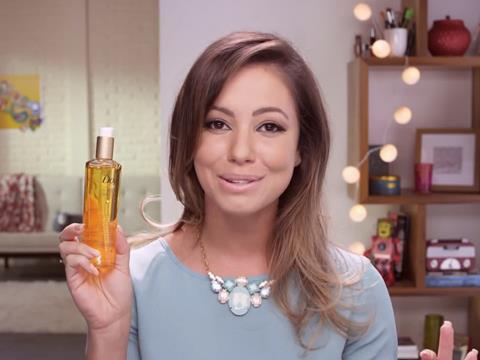
Vlogging (video blogging) is big business (see p36) and Unilever proved itself ahead of the curve in capitalising on the rise of the vlogger in 2014. Using Google data to determine exactly what people were searching for in the way of different hairstyles, the brand owner paid successful beauty vloggers to create said hairstyles in tutorials featuring their products.
Dove Ad Makeover - Dove

Building on its plan to make “real” women feel beautiful, Dove launched a “groundbreaking” Facebook app in 2014, putting the power of advertising in the hands of its customers. Buying up ad space that might previously have been filled with guilt-inducing shots of skinny models, the brand gave those who downloaded the app the chance to replace the slot with compliments to readers.
TV advertising winners
2014 was a brilliant year for fmcg TV ads…here are three of the best
Snickers: Mr Bean
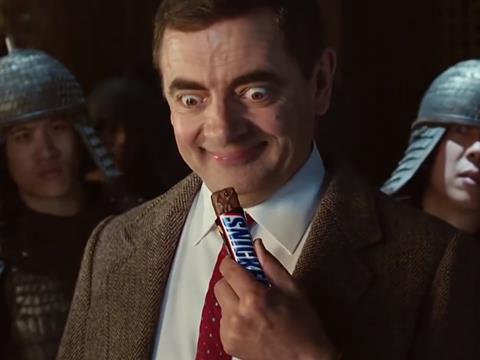
Securing one of the most universally loved characters in your ad is quite a coup, so hats off to the marketing team at Snickers for this instalment in the You’re Not You When You’re Hungry campaign. With Mr Bean crashing through rooftops in an attempt to catch up with his fellow ninjas, the TV ad has a great sense of humour while cleverly positioning the brand as saving the day.
Anchor: Glorious Nothing Days

It’s hard to advertise butter with any panache. But Arla Foods had a good go with its Glorious Nothing Days TV ad campaign in 2014. Going for the soft sell, Arla showed a family relaxing around the house, laughing, joking, and enjoying a slice of toast. It’s a clever move that uses the delicious simplicity of a slice of hot, fresh, buttery toast to its advantage.
Wrigley’s Airwaves: Snakes
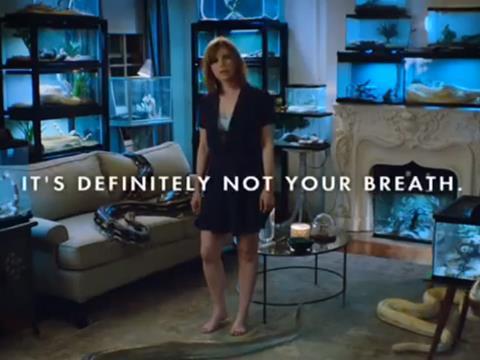
Gum can give you fresh breath but it can’t sort out your unsociable hobbies. That was the message from Wrigley’s with its TV ad campaign in which an unsuspecting guy returns to his date’s home after dinner, only to find it overrun with uncaged snakes. Even minty fresh breath isn’t enough to rescue that date from hell. A quirky but humorous take on oral health.
Most complained about ads
Three fmcg ads that proved controversial in 2014, according to data from the ASA
Flora: The Wrestlers

It wasn’t just the kids (and dog) that were shocked by mum and dad ‘wrestling’ in the 2014 ad for Flora Buttery. The animated ad prompted 183 complaints from viewers who were concerned the content was unsuitable for young children. The ASA refused to uphold the allegation, however, after finding nothing sexually graphic in the scenes advertising a family favourite.
Sainsbury’s Christmas ad

The retailer intended to tug at the heartstrings with its First World War themed Christmas ad in December 2014, but instead it found itself the recipient of 823 complaints to the ASA. Viewers complained teaming up with the Royal British Legion didn’t justify using the horror of WWI to shift slabs of chocolate. The ASA disagreed and refused to ban the commercial.
VIP Electronic Cigarettes

It wasn’t the saucy brunettes glamorising electronic cigarettes that led the ASA to ban this ad in 2014, but the way they exhaled. Following 199 complaints the body ordered VIP Electronic Cigarettes, owned by Must Have Ltd, not to broadcast the ad again in its current form as the way the brunette exhaled created an unacceptable association with traditional tobacco smoking.
Source
Megan Tatum








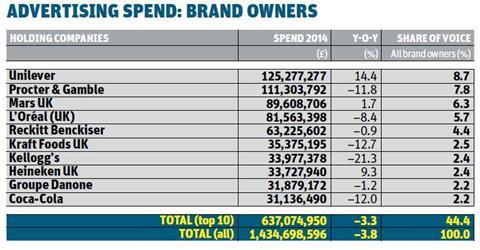
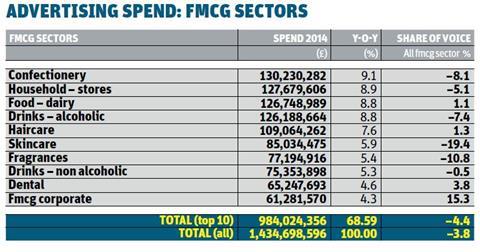
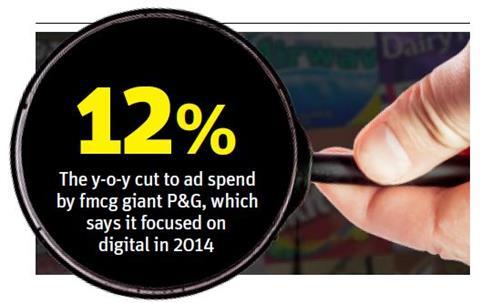
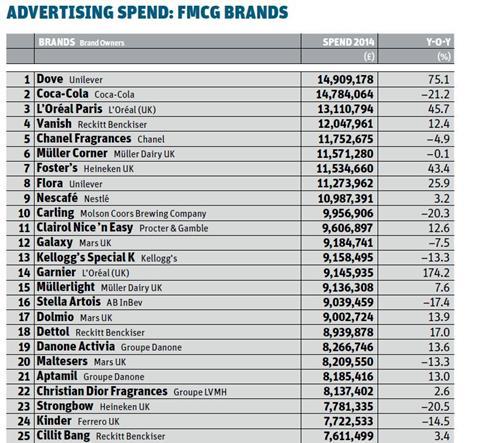
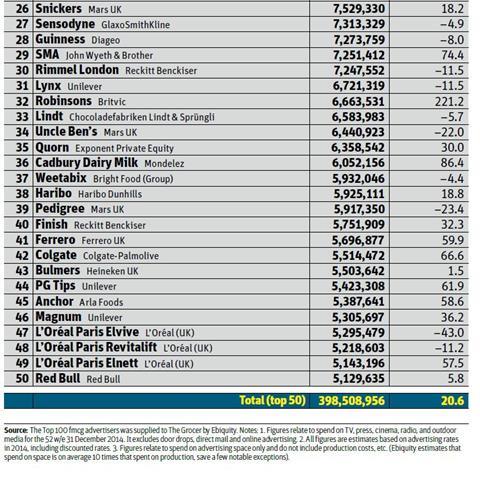
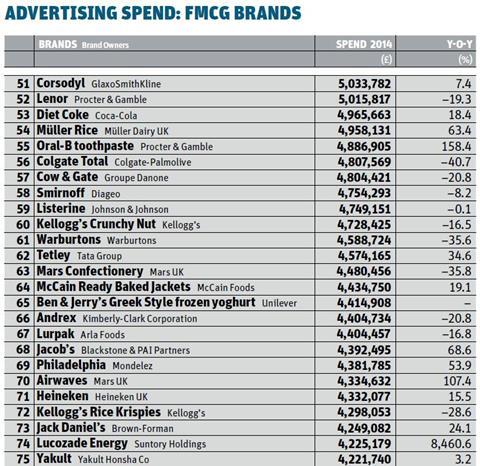
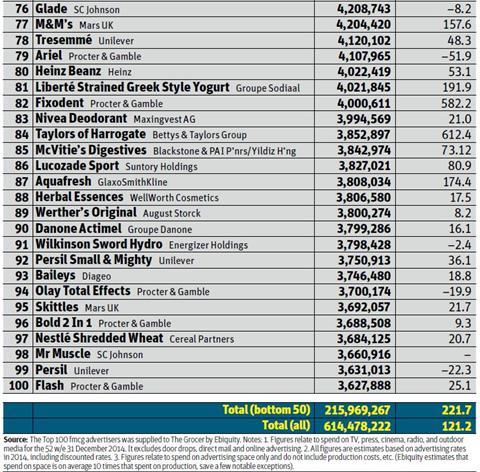

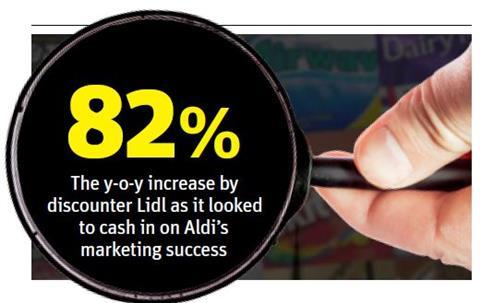
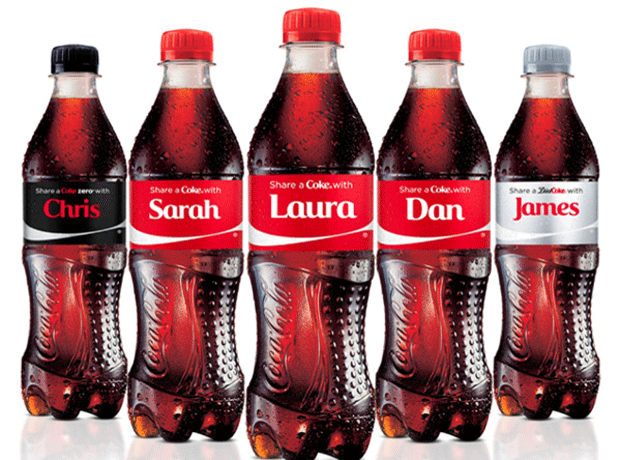
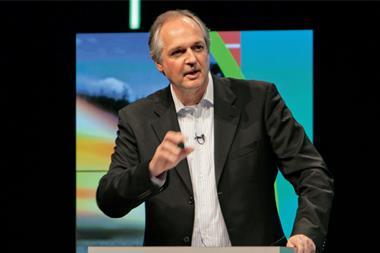
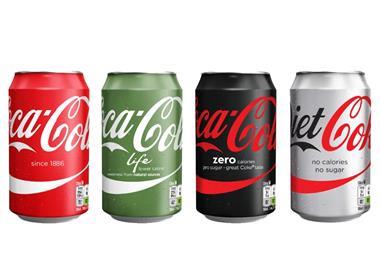

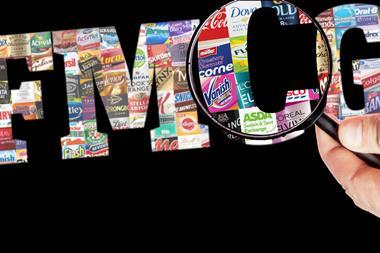
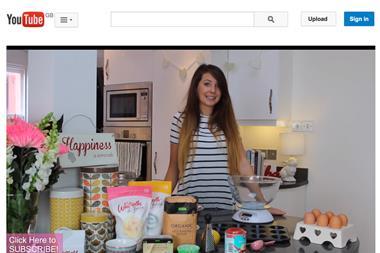






No comments yet